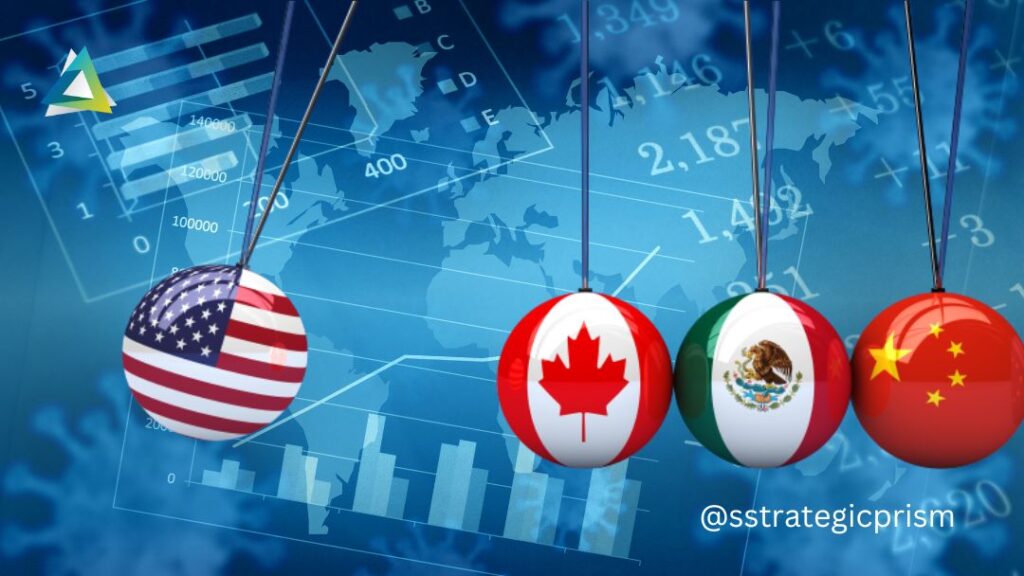 The most intense and unpredictable trade war in modern history has officially begun, with Canada, Mexico, and China all announcing plans to retaliate against a fresh round of tariffs imposed by the United States under President Trump’s administration. These new tariffs mark a dramatic escalation in Trump’s ongoing efforts to reshape America’s trade relationships with its largest trading partners. But to understand what’s happening and why, it’s important to break down both the specifics of the tariffs themselves and the broader economic and political motivations behind them.
The most intense and unpredictable trade war in modern history has officially begun, with Canada, Mexico, and China all announcing plans to retaliate against a fresh round of tariffs imposed by the United States under President Trump’s administration. These new tariffs mark a dramatic escalation in Trump’s ongoing efforts to reshape America’s trade relationships with its largest trading partners. But to understand what’s happening and why, it’s important to break down both the specifics of the tariffs themselves and the broader economic and political motivations behind them.
As of yesterday, Trump’s much-publicized tariffs went into effect, imposing a 25% tariff on goods imported from Canada and Mexico, and a 10% tariff on products from China. These tariffs apply at the point of entry, meaning that any company importing goods into the U.S. from these countries must now pay the additional percentage at the border. In practical terms, if a Canadian automaker exports a vehicle to the U.S. with a sticker price of $50,000, American importers will now need to pay an extra $12,500 in tariffs. That effectively raises the total price of the vehicle to $62,500 before it even reaches the dealership. This increased cost will inevitably be passed on to American consumers, making foreign-made goods significantly more expensive.
So why would Trump deliberately pursue a policy that raises prices for American consumers and businesses? There are two primary reasons, each tied to the administration’s broader economic and political strategy.
Trump’s Economic justification is a two pronged approach.
The first reason is rooted in Trump’s longstanding “America First” economic philosophy, which emphasizes the goal of reducing America’s dependence on foreign goods and boosting domestic manufacturing. By making imported products more expensive, the tariffs are intended to shift consumer and business demand toward American-made alternatives. In theory, if Canadian cars become unaffordable, more Americans might buy vehicles made in Detroit or Ohio. This shift could help reinvigorate U.S. manufacturing industries that have struggled to compete with cheaper foreign products. Over the long term, if successful, this policy could lead to a stronger domestic manufacturing sector, more stable American jobs, and reduced reliance on foreign supply chains.
The second reason is far more tactical and immediate. Trump’s tariffs are designed not just as an economic measure, but as a geopolitical negotiating tool. By targeting Canada, Mexico, and China—America’s largest trading partners—Trump hopes to extract concessions on a variety of trade and economic issues. With Mexico, for example, Trump has frequently voiced his dissatisfaction with the terms of NAFTA (North American Free Trade Agreement) and sought to renegotiate it on terms more favorable to the U.S. With China, Trump has long accused Beijing of engaging in unfair trade practices, including intellectual property theft and currency manipulation. The tariffs serve as leverage in ongoing negotiations, putting economic pressure on these countries in hopes of forcing them to the bargaining table.
However, the response from America’s trading partners has been anything but compliant. Rather than bowing to U.S. demands, Canada, Mexico, and China have all announced plans to retaliate with tariffs of their own. Canada has already unveiled plans for its own 25% tariffs on a range of American goods, targeting key industries and political constituencies in the U.S., such as agriculture and manufacturing. Mexico, while slightly slower to respond, has signaled that it will impose retaliatory tariffs as well, though the exact percentages and product categories are still under review.
China, taking a slightly different approach, has begun preparing to file a formal complaint with the World Trade Organization (WTO), arguing that Trump’s tariffs violate international trade agreements. This strategy highlights the complex and multi-dimensional nature of the conflict, which is playing out not only through direct economic measures but also in legal and diplomatic arenas.
So why is Trump confident enough to provoke such an aggressive response from America’s largest trading partners? The answer lies in the asymmetry of trade dependence between the U.S. and its neighbors. Consider the numbers: In 2023, Canada sent 76% of all its exports to the United States, accounting for roughly 19% of Canada’s total GDP. Mexico is even more reliant, with 78% of its exports going to the U.S., representing approximately 37% of its GDP. For these countries, losing access to the American market would be economically devastating.
In contrast, U.S. exports to Canada and Mexico combined account for only about 2.7% of the U.S. GDP. This enormous imbalance means that while tariffs would certainly hurt some American industries—especially agriculture and automotive manufacturing—the overall U.S. economy is far less vulnerable than those of Canada and Mexico. In Trump’s calculus, this imbalance gives the U.S. the upper hand in any prolonged trade conflict. Even if Canada and Mexico retaliate, the economic damage they can inflict on the U.S. is relatively limited compared to the potential devastation they face if they lose access to the American market.
This power dynamic allows Trump to approach the trade war with a degree of confidence, knowing that Canada and Mexico have far more to lose. However, this strategy also carries significant risks. Prolonged tariffs and retaliatory measures could disrupt deeply integrated North American supply chains, harming industries on both sides of the border. In the auto industry, for example, components often cross the U.S.-Canada or U.S.-Mexico border multiple times during the manufacturing process. Tariffs on each crossing could drastically increase production costs and make North American manufacturers less competitive globally.
Furthermore, the broader uncertainty created by the trade war could chill investment, as companies become reluctant to commit to long-term projects in an unpredictable policy environment. This uncertainty could weigh on financial markets, undermine business confidence, and slow economic growth.
The situation with China is even more complex. Unlike Canada and Mexico, China is not heavily dependent on the U.S. market, with U.S. exports accounting for a much smaller share of China’s GDP. However, China’s export-oriented economy would still suffer from a protracted trade conflict with its largest trading partner. Moreover, China has tools beyond tariffs at its disposal, including regulatory harassment of American companies operating in China, targeted boycotts of American goods, and strategic sales of U.S. Treasury bonds.
Ultimately, the outcome of this trade war remains uncertain. While Trump’s strategy relies on the assumption that America’s economic strength will force its trading partners to capitulate, history shows that trade wars are rarely so predictable. Economic pain can fuel nationalist sentiment and harden resistance, making compromise even more difficult. As Canada, Mexico, and China dig in for a prolonged conflict, the global economy could become collateral damage in a high-stakes gamble for economic dominance.
This escalating conflict highlights the broader shift away from multilateral trade agreements and institutions that have governed the global economy for decades. Trump’s trade war is not just a series of isolated economic skirmishes—it is part of a larger reordering of the global trade system, with the potential to reshape international economic relations for years to come.
The next few years will reveal whether Trump’s gamble pays off or whether the tariffs become yet another cautionary tale of economic nationalism gone wrong. In the meantime, American consumers and businesses are left to navigate an increasingly uncertain landscape, where prices rise, supply chains are disrupted, and economic nationalism collides with global economic reality.

Paramjeet Singh is a researcher and analyst in the field of National Security and Strategic Affairs. His interest in the domain led him to pursue a Master’s degree in Defence and Strategic Studies from Punjab University, where he was a Gold Medalist. Currently, he is pursuing his Ph.D. in the Department of Defence & National Security Studies at Panjab University. Singh has contributed research and analysis on various issues related to national security, strategic influence, and international relations. His research work includes a dissertation on “Cyber Security & Cyber Warfare: Implications on India’s National Security” and research papers on topics such as the Baloch Nationalist Movement, India’s trade relations with adversaries, and disaster vulnerabilities. Topic of his Ph.D. is Cognitive Warfare
Well analysed currently hot topic. Is very important too. Good to start debating the issue.
The political and economic context of the world has changed. Old paradigm is shifting, having been disrupted by the major powers in Europe and east Asia.
Restrengthening and protecting the dollar and its dominance as the global trade driver is essential to the West to regain preeminence in political space.
How all this pans out will be important for global security and stability. The discourse is also changing from subtle diplomacy to loud brazenness.